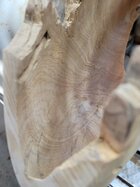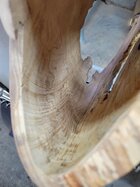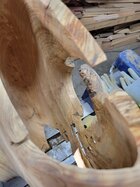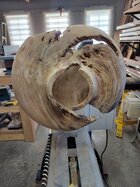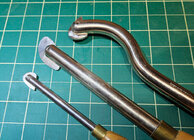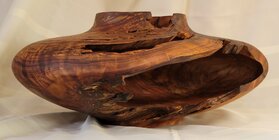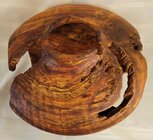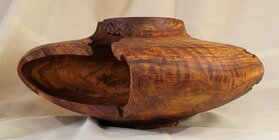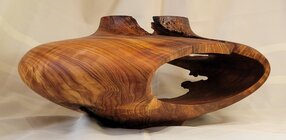Hello everyone, i'm in need of some advice as to how to remove the tool marks on the interior of void-filled hollow forms. This is a piece of western red cedar I believe that I was told got cut off the tree 25 years ago and left in the shade. As a result of this, it had a rather large amount of rot present within as well as significant insect damage.
I understand that cut planning and a well controlled finishing cut is always the best way to limit tool marks and sanding and employ that constantly but this wood was just too rotten and still green for a finishing cut at this thickness. I hollow freehand with a large simon hope hollowing tool and touching this with that at this stage will produce tool marks no matter how I try to approach it.
In retrospect, I just didn't really have the appropriate gear to take on a 20" x 8" hollow form with voids and rot when I began this project and only got to this stage through stubbornness. However, i'd still like to complete the piece and get it to the gallery for a show which means these toolmarks have to go. Thankfully the voids offer pretty good access to all of the interior surface, however hand sanding these out is going to be an extremely long and tedious process.
Any tips and tricks?, Ingenious ideas? Perhaps just the hard truth of the 6+hour hand sanding job ahead of me? Haha. I have a rubber ball on a stick with sandpaper glued onto it but it isn't safe to sand this interior with the lathe running, it would risk the piece and perhaps personal injury.
I understand that cut planning and a well controlled finishing cut is always the best way to limit tool marks and sanding and employ that constantly but this wood was just too rotten and still green for a finishing cut at this thickness. I hollow freehand with a large simon hope hollowing tool and touching this with that at this stage will produce tool marks no matter how I try to approach it.
In retrospect, I just didn't really have the appropriate gear to take on a 20" x 8" hollow form with voids and rot when I began this project and only got to this stage through stubbornness. However, i'd still like to complete the piece and get it to the gallery for a show which means these toolmarks have to go. Thankfully the voids offer pretty good access to all of the interior surface, however hand sanding these out is going to be an extremely long and tedious process.
Any tips and tricks?, Ingenious ideas? Perhaps just the hard truth of the 6+hour hand sanding job ahead of me? Haha. I have a rubber ball on a stick with sandpaper glued onto it but it isn't safe to sand this interior with the lathe running, it would risk the piece and perhaps personal injury.

